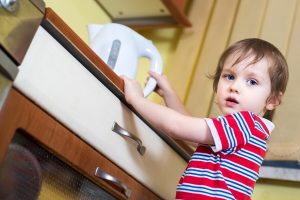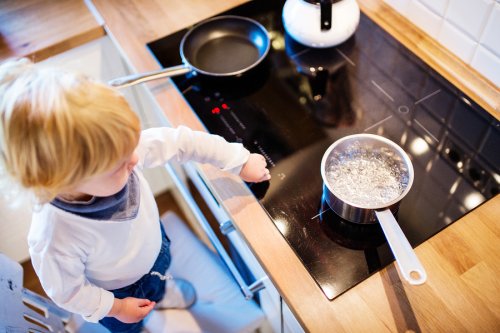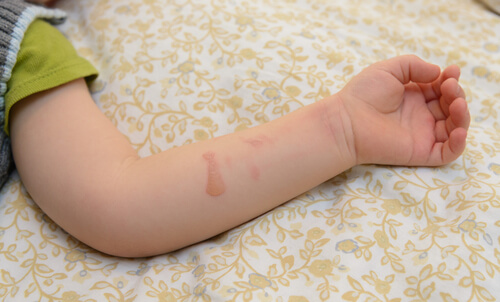What Should I Do If My Child Has Been Burned with Boiling Water?

My child has been burned with boiling water! There’s no doubt most parents would panic if they had to experience such an unfortunate accident with their children.
With this in mind, it’s extremely important to react correctly to these emergency situations. Read on to discover what to do with the different degrees of burns your child could suffer.
Although we’re of course always very careful to protect and look after our children, accidents can still easily happen. Burns in the kitchen rank first among all the most common household accidents involving children.
We must take all reasonable precautions and safety measures to prevent these potential accidents. At the same time, we need to know basic first aid in order to deal with an emergency, such as when a child has been burned with boiling water.
What to do if my child has been burned with boiling water
If your child suffers burns from boiling water, the first thing to do is stay calm. You should then carefully follow these instructions we’re about to give you. In this way you can provide your child with the help he needs in such an emergency.
The first thing to do is quickly move the child away from the kitchen area. Then take him to a bright airy room. Here you’ll be able to evaluate if your child has a first, second or third degree burn.
You’ll be able to decide on what treatment you should be giving him – whether the burn can be treated at home or you should go straight to the hospital.

If your child’s burns are mild, then you can remove the clothing that is in contact with the skin affected by the boiling water. You should then apply cold water to the affected area for around 3 to 5 minutes. This will help relieve the pain.
It’s imperative that you pay special attention to what state your child’s clothes are in. If you can see that they’re stuck to his skin then don’t touch them at all. Instead, go straight to the hospital.
What to do with first-degree burns
First-degree burns cause only superficial damage to the skin. However, that doesn’t mean they won’t cause a lot of pain and become very red and inflamed. First-degree burns will turn the skin a reddish color, as if it were a sun burn, but there won’t be any blisters.
Some simple treatments for very minor burns are:
- To cool the affected area with cold water for at least 5 minutes. It’s important to note that you should never apply ice to the wound, as this will worsen the irritation.
- To give them some ibuprofen-based medicine.
- To apply a hypoallergenic moisturizer, such as aloe vera or other soothing creams.
“If you notice that the child’s clothing is attached to his skin, don’t try to take it off, and go immediately to the hospital”
First-degree burns can heal within 5 days without leaving any type of scar. However, if the affected areas are the face, genitals, hands or feet, then always go to the doctor. Even if you think the burn is very mild, the skin in these areas is particularly vulnerable and requires special attention.

What to do with second and third degree burns
Second and third degree burns can leave scars and marks on the skin if not treated properly. If the burns aren’t treated correctly, then the skin may become deformed or scarred.
If you consider it to be a fairly serious burn, then you should call an ambulance immediately, or go to the hospital yourself if you think that would be quicker.
With second or third degree burns, the skin turns red and swells. Blisters appear immediately and, in the most severe cases, the skin may appear whitish or black. The burnt area can feel numb, but with a lot of pain at the same time.
Of course, it’s important that you know that the best treatment is prevention. Burns produced by hot water are extremely painful. In the worst cases, in just a matter of three seconds of contact with the boiling water, the skin can suffer third-degree burns.
In case of any doubts about what to do with a burn on your child’s skin, consult your doctor or go to the hospital. You shouldn’t stint on treatment in situations like these.
My child has been burned with boiling water! There’s no doubt most parents would panic if they had to experience such an unfortunate accident with their children.
With this in mind, it’s extremely important to react correctly to these emergency situations. Read on to discover what to do with the different degrees of burns your child could suffer.
Although we’re of course always very careful to protect and look after our children, accidents can still easily happen. Burns in the kitchen rank first among all the most common household accidents involving children.
We must take all reasonable precautions and safety measures to prevent these potential accidents. At the same time, we need to know basic first aid in order to deal with an emergency, such as when a child has been burned with boiling water.
What to do if my child has been burned with boiling water
If your child suffers burns from boiling water, the first thing to do is stay calm. You should then carefully follow these instructions we’re about to give you. In this way you can provide your child with the help he needs in such an emergency.
The first thing to do is quickly move the child away from the kitchen area. Then take him to a bright airy room. Here you’ll be able to evaluate if your child has a first, second or third degree burn.
You’ll be able to decide on what treatment you should be giving him – whether the burn can be treated at home or you should go straight to the hospital.

If your child’s burns are mild, then you can remove the clothing that is in contact with the skin affected by the boiling water. You should then apply cold water to the affected area for around 3 to 5 minutes. This will help relieve the pain.
It’s imperative that you pay special attention to what state your child’s clothes are in. If you can see that they’re stuck to his skin then don’t touch them at all. Instead, go straight to the hospital.
What to do with first-degree burns
First-degree burns cause only superficial damage to the skin. However, that doesn’t mean they won’t cause a lot of pain and become very red and inflamed. First-degree burns will turn the skin a reddish color, as if it were a sun burn, but there won’t be any blisters.
Some simple treatments for very minor burns are:
- To cool the affected area with cold water for at least 5 minutes. It’s important to note that you should never apply ice to the wound, as this will worsen the irritation.
- To give them some ibuprofen-based medicine.
- To apply a hypoallergenic moisturizer, such as aloe vera or other soothing creams.
“If you notice that the child’s clothing is attached to his skin, don’t try to take it off, and go immediately to the hospital”
First-degree burns can heal within 5 days without leaving any type of scar. However, if the affected areas are the face, genitals, hands or feet, then always go to the doctor. Even if you think the burn is very mild, the skin in these areas is particularly vulnerable and requires special attention.

What to do with second and third degree burns
Second and third degree burns can leave scars and marks on the skin if not treated properly. If the burns aren’t treated correctly, then the skin may become deformed or scarred.
If you consider it to be a fairly serious burn, then you should call an ambulance immediately, or go to the hospital yourself if you think that would be quicker.
With second or third degree burns, the skin turns red and swells. Blisters appear immediately and, in the most severe cases, the skin may appear whitish or black. The burnt area can feel numb, but with a lot of pain at the same time.
Of course, it’s important that you know that the best treatment is prevention. Burns produced by hot water are extremely painful. In the worst cases, in just a matter of three seconds of contact with the boiling water, the skin can suffer third-degree burns.
In case of any doubts about what to do with a burn on your child’s skin, consult your doctor or go to the hospital. You shouldn’t stint on treatment in situations like these.
All cited sources were thoroughly reviewed by our team to ensure their quality, reliability, currency, and validity. The bibliography of this article was considered reliable and of academic or scientific accuracy.
- Gandhi, M., Thomson, C., Lord, D., & Enoch, S. (2010). Management of Pain in Children with Burns. International Journal of Pediatrics. https://doi.org/10.1155/2010/825657
- Mayo Clinic. Quemaduras: primeros auxilios. Febrero 2022.
- Mayo Clinic. Prevención de quemaduras: protege a tu hijo de las quemaduras. Febrero 2021.
- Jeschke, M. G., & Herndon, D. N. (2014). Burns in children: Standard and new treatments. The Lancet. https://doi.org/10.1016/S0140-6736(13)61093-4
- Sheridan, R. L. (2017). Burns in children. In Journal of Burn Care and Research. https://doi.org/10.1097/BCR.0000000000000536.
This text is provided for informational purposes only and does not replace consultation with a professional. If in doubt, consult your specialist.








